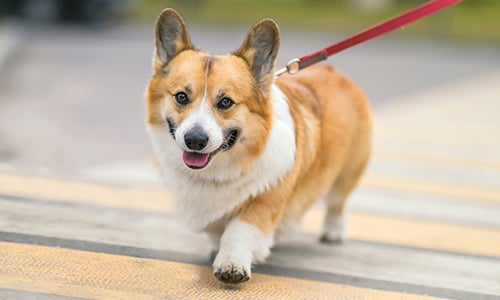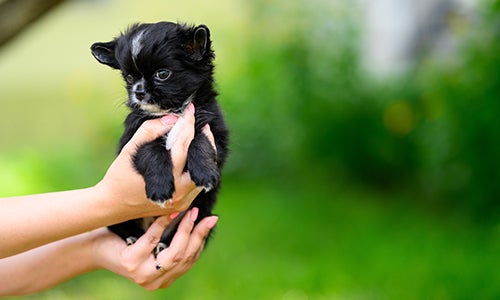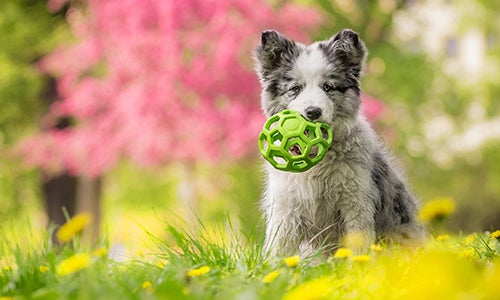Dog Socialization Is a Lifelong Process that Begins in Puppyhood

Socializing the dogs in your kennel should start when they are puppies. Doing so helps to produce friendlier, outgoing puppies. It also contributes to calm adult breeder dogs that are equipped to provide high-quality maternal care to their puppies and that are socialized and ready for adoption into forever homes when they are retired.
“A program for puppy socialization may be the best investment you can make to have more appealing puppies and healthier, happier adult dogs,” says Purina animal behaviorist Annie Valuska, PhD. “Socialization is a fairly small investment in each puppy, and it pays off big time.”
Allan Miller, breeder and owner of Evergreen Elite Puppies in Arthur, Illinois, has been practicing early neurological stimulation exercises and socializing his Pembroke Welsh Corgi puppies for more than 10 years. He has noticed significant differences.
“Number 1 is the satisfaction of customers who give five-star reviews and great feedback,” Miller says. “If you socialize from the beginning, then at 5 to 6 years of age when most people retire and rehome their breeding dogs, they are already social, crate trained and walk well on a leash.”
“It is so important to build a solid foundation when puppies are young,” Dr. Valuska says. “Dogs that get gentle handling and are socialized from 3 to 12 weeks of age are more likely to have confidence and do well when they are exposed to new things.”
“The good news is that even old dogs can learn new tricks,” she adds. “With older dogs that have had little socialization, you want to start with shorter, more frequent sessions. You do not want to stress the dog or create a negative experience.”
Miller’s beliefs about the importance of dog socialization and the role it plays in helping to rehome retired adult breeder dogs led to his founding the Illinois Companion Animal Rehoming Ethically (ICARE) program in 2022.
“Our concept was based on the need for responsible rehoming of adult breeder dogs and providing the best match with the right home for the right dog,” Miller says.
“Some dogs are in the breeder’s facility their whole life, and when they go to a new place, they cower in fear,” he says. “One of our first efforts has been to educate breeders about socializing their kennel dogs starting as puppies.
” The long-term goal of ICARE is to have a facility with full-time staff, Miller says. Currently, ICARE places retired breeder dogs that are socialized into one of the organization’s two foster homes until they are adopted into carefully screened forever homes. ICARE also works with nine dog rescues in Illinois to place dogs with their foster families to help build socialization skills and prepare them for adoption.
“New breeders join ICARE all the time,” Miller says. “We place a high standard for the dogs we take in. They must be bathed and groomed and current on veterinary care and vaccinations. We want them to be leash trained and able to go to a new place without being fearful.”
Catching up on socialization skills with adult dogs requires taking baby steps, Miller says. “You want to start by taking them for a short 5-minute walk, and then the next time, walk them in a different direction. You can always tell when the mental stimulation is too much.

“Some dogs take two weeks to a month to overcome their fears, and others may take six weeks or more. Once they are confident, you can take them all over and continue to expose them to new experiences.”
A calm, socialized adult female dog contributes immensely to the health and well-being of her puppies. “Puppies’ socialization journey begins in utero,” Dr. Valuksa says. “Exposure of the dam to stressors negatively impacts the immune system status, neuroendocrine development and social behavior of her puppies.
“The best way to reduce maternal stress is to offer her control of her environment. You want to give her an area where she can hide if she chooses. She should have frequent human social interactions throughout pregnancy and opportunities to exercise. An enriched environment is linked to better maternal care of puppies.”
Citing research published in 2018 in the journal Behaviour, Dr. Valuksa says, “Studies have found that dams that provided high levels of maternal care produced puppies that were less anxious, less fearful of novelty, more social and more interactive with their environment.
“Socialization really starts with the mom. The better care you give her, she will make your job a lot easier.” Miller adds another benefit of dog socialization. “Ultimately, it improves the breeder’s image to have socialized dogs,” he says. “Socialization is going to create dogs that are going to thrive in a home.”
As ICARE works toward its goals, Miller says, “We’ve seen a huge increase in the quality of dogs we rehome. Breeders are trying to do the right things and starting to understand how much better their adults are with more stimulation and training throughout their lives.”
Three Key Principles of Dog Socialization
1) Start Socialization with Puppies for the Biggest Impact
The U.S. military’s “Super Dog” early neurological stimulation exercises1 from day 3 through day 16 made puppies more resilient to stress as adults and improved cardiovascular, adrenal and immune function. It involves spending 3 to 5 seconds daily on each of five exercises: tactical stimulation with a cotton swab between the toes; head held erect above the tail; head pointed down toward the ground; supine position on the back with muzzle facing the ceiling; and thermal stimulation using a cool, damp towel.

"One study found that frequent gentle handling from day 3 through day 21 resulted in significantly calm puppies at 8 weeks of age.2 This made an even greater impact on puppies raised in large-scale breeding operations than those raised in a home environment."
Puppies exposed to standardized socialization protocol of one time a day over five days a week, ranging from 5 minutes per puppy at weeks 1 and 2 to 10 minutes at weeks 3 and 4 to 15 minutes at weeks 5 and 6, had significantly better scores on separation anxiety, distraction, anxiety and body sensitivity at 6 months of age.3
2) Create Positive Experiences So Socialization Is Fun for the Dog
Manage the dog’s exposure to new experiences. All activities should take place below the fear threshold when the dog is interested but not afraid or stressed. Create a socialization staircase using short, frequent sessions to establish confidence and ensure that your dog has positive experiences. One study4 found that puppies that had negative experiences with stimuli were more likely to become fearful than puppies that had no exposure at all to those stimuli.

3) Reward the Dog at the Right Time for Appropriate Behavior
A dog that is calmly responding to a new stimulus should be reinforced for that behavior with praise or treats. This will link the new experience to something good happening. Over time, those links will build a positive cognitive bias toward new things, resulting in a more confident and less fearful dog.
Sources:
Dr. Annie Valuska, Principal Scientist, Nestlé Purina Pet Behavior Team.
1 Battaglia CL. Journal of Veterinary Behavior. 2009;4(5):203-210.
2 Gazzano A, Marifi C, Notari L, et al. Applied Animal Behaviour Science. 2008;110(3-4):294-304.
3 Vaterlaws-Whiteside H, Hartmann A. Applied Animal Behavior Science. 2017;197:55-61.
4 England G. Dog Breeding, Whelping and Puppy Care. 2013. Wiley-Blackwell, Hoboken, New Jersey.
